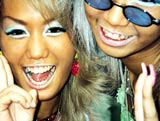Big in Japan
Francesca Syz visits Tokyu!Wow, a multimedia exposition of modern cultural and consumer trends in the Japanese capital

OK, so I happen to think belly button tape is a good idea (just how does that fluff get in there, anyway?), but mouth stretchers and paper pants do seem a little beyond the call of duty for your average product designer. But then the Japanese are not your average consumers. This is the subject of Tokyu!Wow, an exhibition opening in Soho this week, which looks at Tokyo culture through its everyday consumer products.
The idea for the exhibition comes from advertising agency Bartle Bogle Hegarty employee Nick Barham, whose official title is “cultural reporter”. His job is to search the globe for the latest consumer trends. In May, Barham went to Tokyo with freelance creative director Shona Heath. They took photographs and bought “normal” objects from a local department store, Tokyu Hands. “It wasn’t about trying to find the weirdest stuff,” says Barham, “but the most ordinary. They just seem weird to us.”
Walking around the exhibition, I can identify two main target groups. First, the brand- and logo-loving teenagers. Coming from a racially homogenous culture as they do, they are all the more determined to acquire a look, which is not their natural one. Photographs show posters and flyers splashing the faces of celebrity models and musicians across public walls in Tokyo. These are the the trend-setters.
For example, a current cult, Gunguro, was initiated by a pop singer, Namie Amuro, whose tanned look has sent hundreds of kids into a frenzy of hair bleaching, skin tanning and thick white lip and eye make-up. Girls also aspire to look cute – “kawaii”, and the sexy, little girl image – celebrated by the schoolgirl phenomena – is very fashionable. There are even magazines with names like “Cutie”à which teach you how to enhance your cuteness. It seems likely that this is in response to the harsh work ethic of adults – and the desire of young women to have fun before employment or marriage. Some Japanese intellectuals have even gone as far as to pronounce the schoolgirl movement a political one, a post feminist reaction to what is still largely a male dominated society.
The second target group is the desk jockey, mostly grown-ups. They frequently work 18-hour days and gratefully purchase practical products, like the Ear Alarm, which wakes you just before your stop on the commuter train, the Eye Cooler Packs and, yes, Sock Holding Up Glue.
Perhaps out of nostalgia for their lost youth, this group also seems to want the cartoon logos. So however mundane the product, from fly swat to fax machine, it still comes in its immaculate plastic package, complete with bright little cartoon character. Even condoms – little yellow boxes with a picture of two kittens on the side and the words Love Cats scrawled across the top – are cute.
The exhibition also addresses common themes like hygiene: Fresh Kiss is an electronic halitosis monitor shaped like a mobile phone. Another theme is body image – the packet suggests using the Mouth Stretcher for two to three minutes a day for successful mouth enhancement. For overall face improvement there’s the Super Shape-Up Face: an electronic device that sends gentle toning pulses into your cheeks.
Beside products, the exhibition also features photographs, murals and flyers plastered to the walls, Tokyo-style. Barham hopes people will just drop in. “It’s not a high-brow analysis of another culture,” says Barham, “but more an opportunity to sample some bite-sized pieces of Japan.” It seems interesting that someone who works for an advertising agency should choose to highlight how manipulated by the media an entire culture can be. I also think it’s sad how many products on the market in Japan encourage people to change themselves. But I tell you what, I wouldn’t mind a go on one of those Nose Shapers.
Tokyu!Wow is showing at Merc House, 15-21 Ganton Street, London W1 from 11-28 September
-
Post a comment




